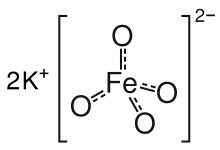|
Potassium ferrate
Potassium ferrate is an inorganic compound with the formula K2FeO4. It is the potassium salt of ferric acid. Potassium ferrate is a powerful oxidizing agent with applications in green chemistry, organic synthesis, and cathode technology. SynthesisGenerally, there are three ways to produce hexavalent iron: dry oxidation, wet oxidation, and electrochemical synthesis.[2] The methods used to produce potassium ferrate are similar to those used to produce sodium ferrate and barium ferrate. Dry oxidationThe dry oxidation method entails heating or melting iron oxides in an alkaline, oxygenated environment. The combination of high temperature (200 °C - 800 °C) and oxygen presents an explosion hazard that has led many researchers to believe this method of production is not suitable from a safety viewpoint, although many attempts have been made to overcome this problem.[2][3] Wet oxidationIn the wet oxidation method, K2FeO4 is prepared by oxidizing an alkaline solution of an iron(III) salt. Generally, this method employs either ferrous (FeII) or ferric (FeIII) salts as the source of iron ions, calcium, sodium hypochlorite (Ca(ClO)2, NaClO), sodium thiosulfate (Na2S2O3) or chlorine (Cl2) as oxidizing agents and, finally, sodium hydroxide, sodium carbonate (NaOH, NaCO3) or potassium hydroxide (KOH) to increase the pH of the solution.[4][5][6] For example:
Electrochemical synthesisElectrochemical methods used to synthesize potassium ferrate usually consist of an iron anode which electrolyzes a KOH solution.[3] Properties Potassium ferrate is a dark purple crystalline solid that dissolves in water to form a reddish-purple solution. The salt is paramagnetic and is isostructural with K2MnO4, K2SO4, and K2CrO4. The solid consists of K+ and the tetrahedral FeO2−4 anion, with Fe-O distances of 1.66 Å.[7] Potassium ferrate decomposes rapidly in neutral and acidic water, e.g.:[8]
In alkaline solution and as a dry solid, K2FeO4 is stable. Under the acidic conditions, the oxidation–reduction potential of the ferrate(VI) ions (2.2 V) is greater than that of ozone (2.0 V).[9] ApplicationsLike sodium ferrate, K2FeO4 generally does not generate environmentally toxic by-products and can be used in water treatment processes.[2] It can act as:
In addition, potassium ferrate can be used as a bleeding stopper for fresh wounds.[10][11] In organic synthesis, K2FeO4 oxidizes primary alcohols.[12] K2FeO4 has also attracted attention as a potential cathode material in a "super iron battery."[13] Stabilised forms of potassium ferrate have been proposed for the removal of transuranium elements, both dissolved and suspended, from aqueous solutions.[14] Tonnage quantities were proposed to help remediate the effects of the Chernobyl disaster in Belarus [citation needed]. This new technique was successfully applied for the removal of a broad range of heavy metals. Work on the use of potassium ferrate precipitation of transuranium elements and heavy metals was carried out in the Laboratories of IC Technologies Inc. in partnership with ADC Laboratories, in 1987 though 1992. The removal of the transuranium elements was demonstrated on samples from various Dept. of Energy nuclear sites in the USA.[citation needed] Because the side products of its redox reactions are rust-like iron oxides, K2FeO4 has been described as an "environmentally friendly" oxidant. In contrast, related oxidants such as chromates are considered environmentally hazardous.[15] HistoryIn 1702, Georg Ernst Stahl (1660 – 1734) observed that the ignition product of potassium nitrate (saltpetre) and iron powder displayed a red-purple color in an aqueous solution, which was eventually attributed to hexavalent potassium ferrate. Eckenberg and Becquerel in 1834 reported that a red-purple color appeared during heating of a mixture of potassium hydroxide and iron ore. In 1840, Edmond Frémy (1814 – 1894) discovered that fusion of potassium hydroxide and iron(III) oxide in air produced a high-capacity iron compound that was soluble in water:[3]
References
|
||||||||||||||||||||||||||||||||||||||||||||||||||||||||||||||||||||||||||


